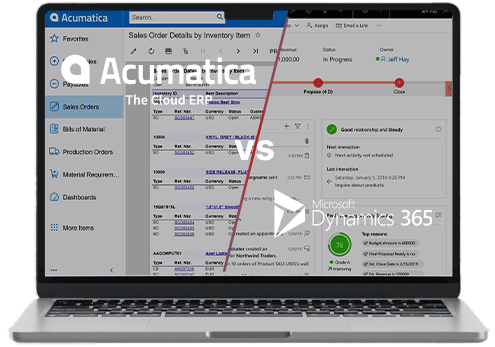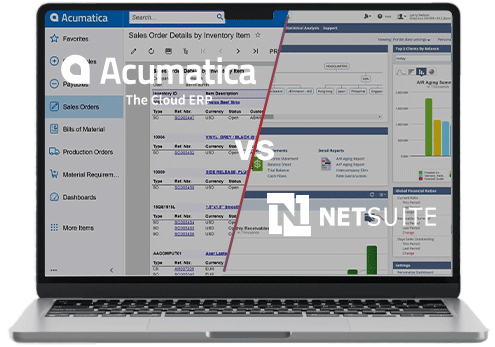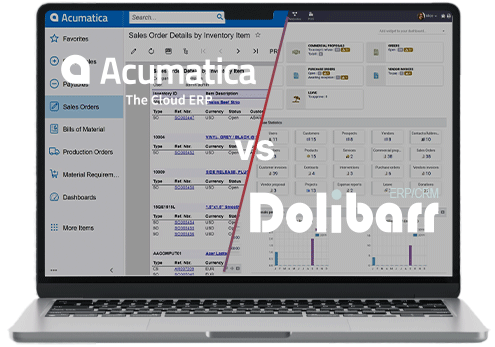acumatica vs microsoft dynamics 365 : an erp comparison
What are the differences between these two business management software?

acumatica
Acumatica is an integrated ERP solution that offers various modules to meet the evolving needs of businesses. With advanced customization options and seamless cloud integration, Acumatica enables companies to remain agile and adapt to market changes. Its suite of modules covers various aspects of business management, from finance to supply chain, providing a comprehensive solution to effectively manage all operations. With a focus on customization, flexible pricing, and ease of deployment, Acumatica offers a modern approach to address the management challenges faced by businesses.
10,000+ customers
7 offices in North American
Adapted for Mid-Market Businesses
+150 apps availables on Acumatica Marketplace
microsoft dynamics 365
Microsoft Dynamics 365 is designed for SMEs and offers a wide range of tools to manage different aspects of your business, such as finances and supply chain. Its flexibility makes it a good choice for growing businesses as it can be tailored to your specific needs. Additionally, it easily integrates with other Microsoft products and third-party applications, making it easier to manage your business from one place. This ERP solution is reliable, integration-focused, and compatible, providing a solid foundation to support the growth and innovation of your business while addressing the complex challenges of business process management.
19,000 Companies
30 Countries
12,000 User group Members
25 Languages

Acumatica vs Microsoft Dynamics 365
Which ERP is better for your business?
When comparing Acumatica and Microsoft Dynamics 365, it's essential to consider the needs and requirements of your business. Both systems offer a variety of features and benefits that can help your business grow and improve its efficiency.
Acumatica and Microsoft Dynamics 365 are ERP systems designed to help businesses become more efficient. They differ in customization, pricing, implementation, and features. Acumatica is flexible, meaning it can be adjusted without requiring extensive programming, which is beneficial for growing businesses. Microsoft Dynamics 365 easily integrates with other Microsoft tools, allowing for advanced customization, but this may require technical skills.
To choose between Acumatica and Microsoft Dynamics 365, it's important to understand your business's specific needs in terms of features, flexibility, and budget. An experienced ERP consultant can greatly assist you in this process, ensuring successful integration of the chosen solution.
Learn more about acumatica and microsoft dynamics 365
LEVEL OF CUSTOMIZATION
Acumatica is renowned for its flexibility. Companies can easily customize modules to meet their requirements without requiring complex coding. This modularity enables exceptional scalability, making Acumatica a better solution for growing businesses.
Microsoft Dynamics 365 also offers a high level of customization, but it excels particularly due to its seamless integration with other Microsoft products such as Office 365 and Power BI. This merging allows for advanced configuration, although it may require technical expertise to maximize its potential.
PRICING
Acumatica's pricing model is usage-based, meaning that companies pay based on the resources they consume. This can be particularly advantageous for small and medium-sized businesses looking to control their costs.
In contrast, Microsoft Dynamics 365 uses a per-user pricing model, which can become expensive as the number of users increases. However, for large enterprises, this model can be more predictable and manageable.
SOFTWARE IMPLEMENTATION
Acumatica implementation is typically quick and flexible due to its modern cloud architecture. Companies can choose between on-premises, private cloud, or public cloud deployments, providing great flexibility to meet their requirements.
Microsoft Dynamics 365 benefits from the infrastructure of Microsoft Azure, ensuring high performance and enhanced security. However, implementation can be more complex and often requires significant technical expertise, especially to fully integrate all available functionalities.
module comparison between acumatica and microsoft dynamics 365
Sales force management
Acumatica offers comprehensive tools for managing sales opportunities, quotes, orders, and sales forecasts. The system's flexibility allows sales processes to be adapted to the expectations of each business. Microsoft Dynamics 365 integrates advanced sales force management features, often enhanced by combining with other Microsoft tools such as Outlook and LinkedIn Sales Navigator. This integration allows for sales process automation.
CRM
The built-in CRM features in Acumatica facilitate centralized management of contacts, opportunities, and customer interactions, thereby simplifying customer relationship management and access to strategic information. In comparison, Microsoft Dynamics 365 stands out for its advanced CRM capabilities, offering a comprehensive range of tools for marketing, customer service, and sales automation, bolstered by its integration with other Microsoft products.
Features
Acumatica offers modular functionalities that can be tailored to the specific needs of the business, with a strong emphasis on flexibility and scalability. Modules include financial management, supply chain management, project management, and much more. Microsoft Dynamics 365 provides a wide range of integrated features that can be extended with additional modules and third-party applications. This extensibility allows businesses to create a customized ERP solution according to their requirements.
Accounting
Acumatica's comprehensive accounting tools encompass financial management, billing, and payments, with a usage-based pricing model. This pricing flexibility allows businesses to pay only for the services they use. In contrast, Microsoft Dynamics 365 offers robust accounting features seamlessly integrated with other Microsoft applications to ensure consistent financial management. This implementation enables holistic financial management, linking accounting with other operational aspects of the business.
Reporting
Acumatica enables the creation of custom reports with built-in analytics tools accessible via the cloud. Users can create detailed reports and visualize data in real-time for informed decision-making. Microsoft Dynamics 365 utilizes Power BI for advanced reporting and analytical capabilities, enabling real-time data visualizations and reports. Power BI offers powerful tools for analyzing and interpreting data, thereby enhancing businesses' ability to make strategic decisions based on reliable data.
Technical specifications
Based on modern cloud architecture, Acumatica offers great flexibility and deployment options tailored to the needs of SMEs. Companies can choose between on-premises, private cloud, or public cloud deployments, depending on their preferences and requirements. In contrast, Microsoft Dynamics 365 leverages the Microsoft Azure infrastructure, ensuring enhanced security, high performance, and native integration with other Microsoft solutions.
- https://fr.acumatica.com/erp-comparison/comparing-acumatica-vs-microsoft-dynamics-365-business-central/
- https://www3.technologyevaluation.com/comparison-reports/acumatica-cloud-erp-56937-vs-dynamics-365-16368
- https://www.elevatiq.com/post/acumatica-vs-ms-dynamics-365-fo-independent-review/
- https://www.selecthub.com/erp-software/acumatica-vs-dynamics-365-erp/
- https://www.trustradius.com/compare-products/acumatica-vs-microsoft-dynamics-365-business-central
To conclude on acumatica vs microsoft dynamics 365
The choice between Acumatica and Microsoft Dynamics 365 will largely depend on your company's specific requirements, budget, and ability to configure and implement solutions. Acumatica stands out for its flexibility, usage-based pricing model, and quick implementation, making it an attractive solution for growing SMEs. On the other hand, Microsoft Dynamics 365 offers tight integration with the Microsoft ecosystem, powerful CRM capabilities, and a superior infrastructure through Azure, making it recommended for large enterprises or those already integrated into the Microsoft ecosystem.
At Captivea, we are experts in ERP solutions, ready to assist you in choosing between Acumatica and Microsoft Dynamics 365. Contact us for a personalized consultation and discover how we can enhance your business management with the right ERP.
Explore additional acumatica ERP comparisons
FAQ on acumatica vs microsoft dynamics
Acumatica is an integrated ERP solution that offers various modules to meet the evolving needs of businesses. With advanced customization options and seamless cloud integration, Acumatica enables companies to remain agile and adapt to market changes.
Microsoft Dynamics 365 is designed for SMEs and offers a wide range of tools to manage different aspects of your business central, such as finances and supply chain.
When comparing Acumatica and Microsoft Dynamics 365, it's essential to consider the central business needs and requirements. Both systems offer a variety of features and benefits that can help your business central grow and improve its efficiency.
Acumatica and Microsoft Dynamics 365 are both ERP systems designed to help business central become more efficient. They differ in customization, pricing, implementation, and features.
Acumatica is renowned for its flexibility and customization options. Companies can easily adjust modules to meet their specific business central requirements without extensive programming.
Acumatica's pricing model is usage-based, while Microsoft Dynamics 365 uses a per-user pricing model. Both have their advantages depending on the business's central size and structure.
Acumatica offers flexible deployment options including on-premises, private cloud, or public cloud, catering to different business units and preferences.
Acumatica offers modular functionalities like financial management, supply chain management, and project management. Microsoft Dynamics 365 provides integrated features and can be extended with additional modules and third-party add ons.
Acumatica offers comprehensive tools for sales order management and sales forecasts, with flexibility to adapt to business central goals.Microsoft Dynamics 365 integrates advanced sales force management features.
Acumatica has built-in CRM features for centralized management of contacts and customer interactions. Microsoft Dynamics 365 offers advanced CRM capabilities, enhanced by integration with other Microsoft products.
Acumatica, based on modern cloud architecture, provides flexibility in deployment. Microsoft Dynamics 365 leverages Microsoft Azure infrastructure for enhanced security and performance. Computing power required varies depending on the deployment and usage.
Acumatica includes comprehensive tools, ensuring efficient tracking and management of payments and outstanding balances.
Acumatica and Microsoft Dynamics 365 both offer robust distribution management capabilities to streamline supply chain processes, ensuring efficient logistics and inventory control for business central operations.
Acumatica provides comprehensive tax management tools to ensure compliance and streamline tax-related processes for businesses of all sizes.
Both Acumatica and Microsoft Dynamics 365 may incur additional costs depending on specific business central needs and customization requirements.









